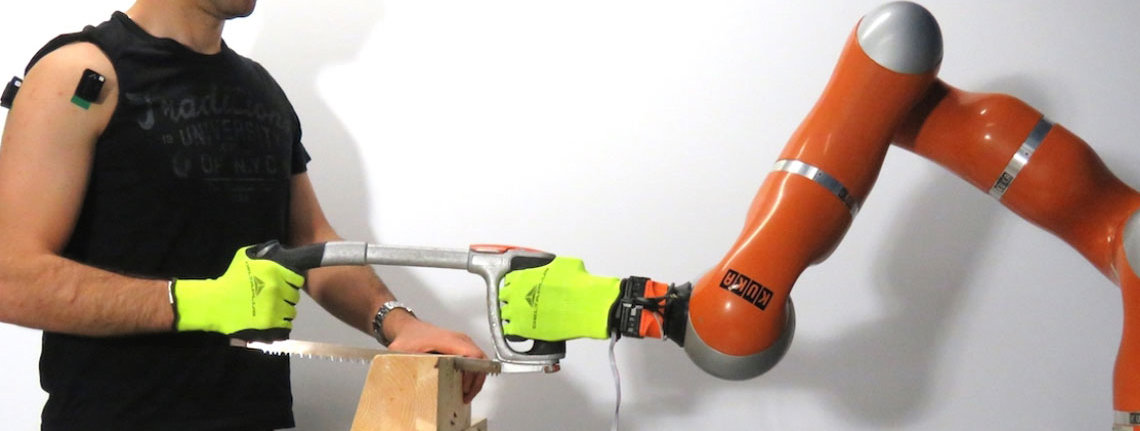Physical Human Robot Interaction and Collaboration

Physical human-robot interaction and cooperation are two fundamental and necessary aspects for integrating robots into our daily lives. The robots are expected to help us in various tasks, of which many require collaborative effort to be successfully completed. In order to achieve such behaviour, the robot must be able to physically interact with the human counterpart and predict the intentions of the human, despite the additional interaction with the uncertain and unpredictable environment. Appropriate robot control methods therefore are essential for the robot to deal with various uncertainties, dynamically aspects and complex task requirements. A promising direction towards this goal is to adaptively regulate mechanical parameters of the robot, based on the task requirements and external feedback.
Multi-Modal Human Robot Interfaces
An important aspect of robot control in human-robot interaction/collaboration is the presence of the human. The human behaviour is usually highly unpredictable and difficult to model. Indeed recent work at HRI2 laboratory aims at developing appropriate human-robot interfaces to enable the robot to predict or extract the human intention from various feedback modalities (human motor behaviour, vision, interaction force, voice commands, etc.). In addition, other key aspects such as role-allocation in human-robot cooperation and partner’s skill evaluation, which can enable the robot to adapt its behaviour to accommodate for different level of competence and capability of the human will be explored. Our novel techniques are applied to the IIT humanoid robots such as COMAN, iCub, and WALK-MAN in human-humanoid collaborative settings.
- A. Ajoudani, "Transferring Human Impedance Regulation Skills to Robots", Tracts in Advances Robotics Star, Springer, 2016.
- L. Peternel, N. Tsagarakis, and A. Ajoudani, "Towards Multi-Modal Intention Interfaces for Human-Robot Co-Manipulation", IEEE International Conference on Intelligent Robots and Systems (IROS), 2016.
Modeling and Adaptation to Human Physical Fatigue In HRC
Our work here focuses on the development of methods that allow a robot to adapt its physical behaviour to the human fatigue in human-robot co-manipulation tasks. This can be achieved by the robot initially imitating the human to perform the collaborative task in a leader-follower setting, using a feedback about the human motor behaviour. Simultaneously, the robot can obtain the skill in online manner. When a predetermined level of human fatigue is detected, the robot can use the learnt skill to take over the physically demanding aspect of the task and contributes to a significant reduction of the human effort. The human, on the other hand, will control and supervise the high-level interaction behaviour and will perform the aspects that require the contribution of both agents in such a dynamic co-manipulation setup. A video of a sample experiment is available for ahuman-robot collaboration task.
- L. Peternel, C. Fang, N. Tsagarakis, and A. Ajoudani, "Online Human Muscle Force Estimation for Fatigue Management in Human-Robot Co-Manipulation", IEEE International Conference on Intelligent Robots and Systems (IROS), 2018.
- L. Peternel, N. Tsagarakis, D. Caldwell and A. Ajoudani, "Robot Adaptation to Human Physical Fatigue in Human-Robot Co-Manipulation", Autonomous Robots, Special Issue on Learning for Human-Robot Collaboration, 2017, accepted.
Ergonomic Human-Robot Collaboration
In his line of reserach, we develop novel HRC frameworks to take into account the ergonomic requirements for the human co-worker. The robots use a whole-body dynamic model of the human to optimise for the position of the co-manipulation task in the workspace. In this configuration, the overloading joint torques, i.e. the effects of an external load in human body joints, are minimised. In addition, the optimisation process includes several constraints, such as human arm manipulability properties, to ensure that the human has a good manipulation capacity in the given configuration. The main advantage of this approach is that the robot can potentially help to reduce the work-related strain and increase the productivity of the human co-worker.
- W. Kim, J. Lee, L. Peternel, N. Tsagarakis and A. Ajoudani, "Anticipatory Robot Assistance for the Prevention of Human Static Joint Overloading in Human-Robot Collaboration", IEEE Robotics and Automation Letters (RA-L), 2017.
- L. Peternel, W. kim, J. Babic, and A. Ajoudani, "Towards Ergonomic Control of Human-Robot Co-Manipulation and Handover", IEEE International Conference on Humanoid Robots (Humanoids), 2017.
- M. Lorenzini, W. Kim, E. De Momi, and A. Ajoudani, "A Synergistic Approach to the Real-time Estimation of the Feet Ground Reaction Forces and Centres of Pressure in Humans with Application to Human-Robot Collaboration", IEEE Robotics and Automation Letters (RA-L), 2018.
- W. Kim, M. Lorenzini, K. Kapicioglu, and A. Ajoudani, "ErgoTac: A Tactile Feedback Interface for Improving Human Ergonomics in Workplaces", IEEE Robotics and Automation Letters (RA-L), 2018.
- A. Ciullo, M. Catalano, A. Bicchi, and A. Ajoudani, "A Supernumerary Soft RoboticHand-Arm System for Improving Worker Ergonomics", The International Symposiumon Wearable Robotics (WeRob), 2018.
